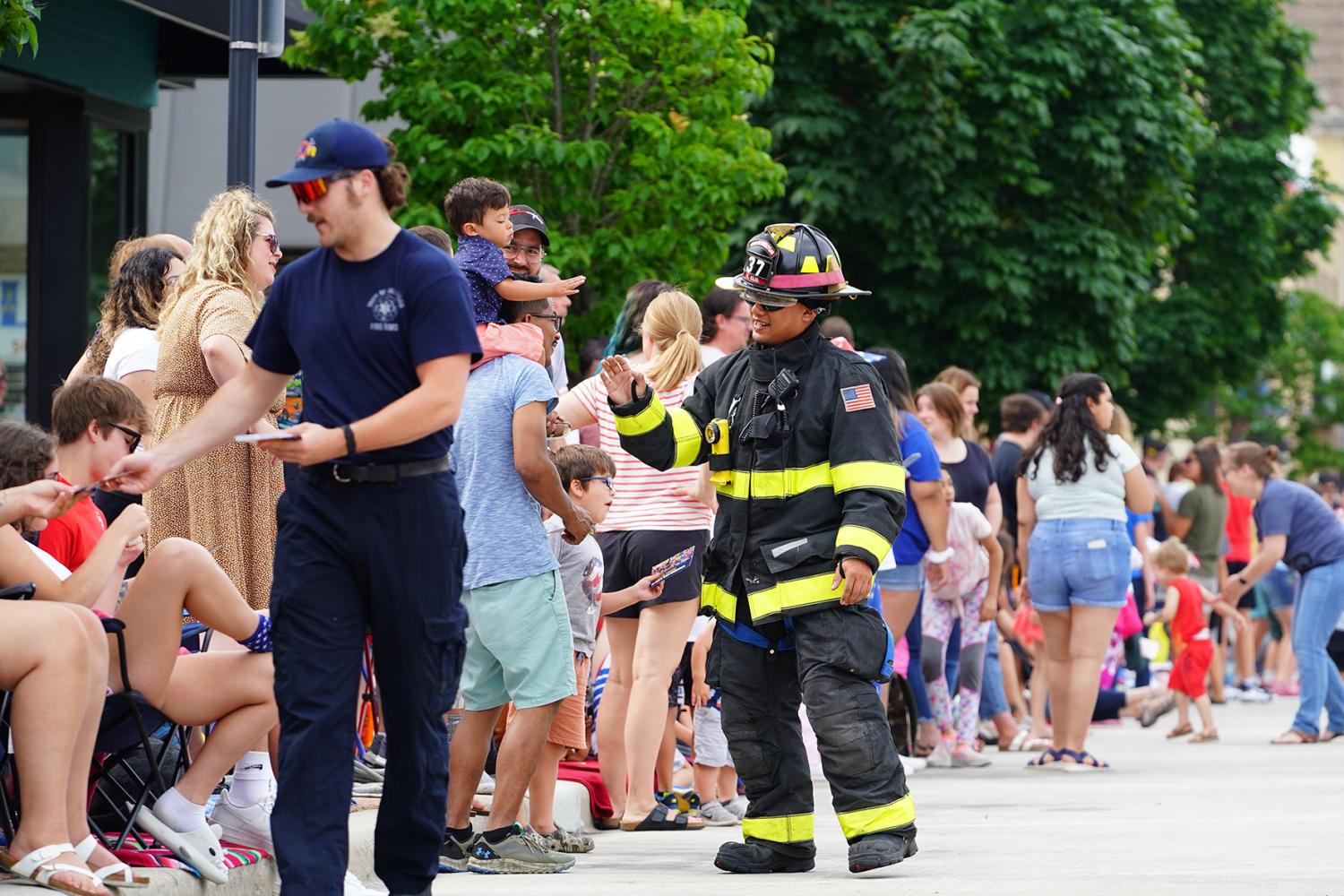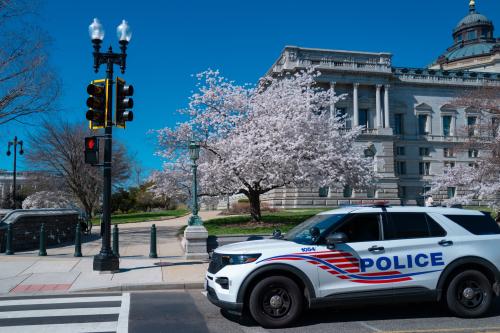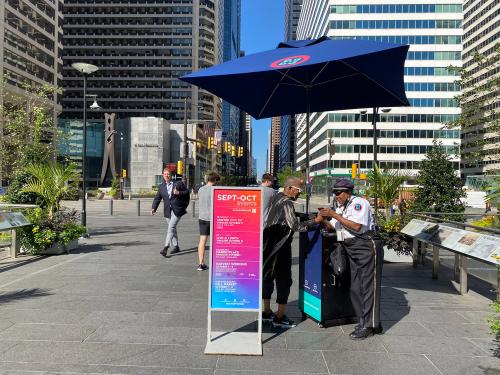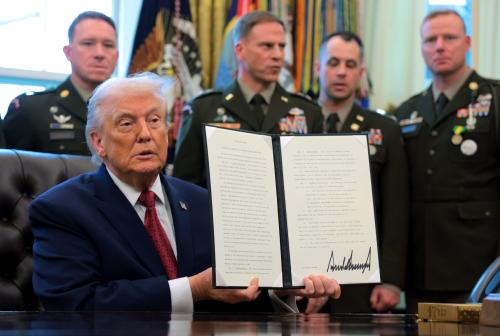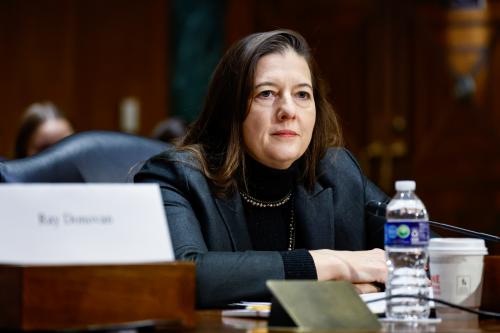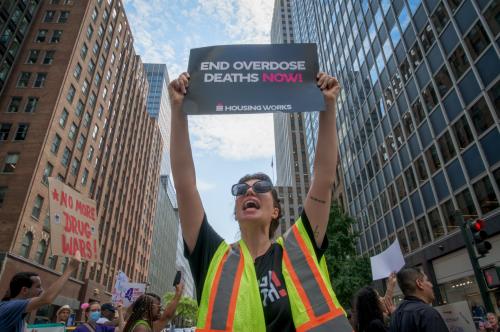Introduction
States and localities are facing a critical crossroads in public safety policymaking. Following decades-long declines in crime, homicides spiked in 2020 by nearly 30% nationwide and then fell sharply from 2023 on. Today, violent crime rates are near historic lows, due in part to the increased adoption of upstream community safety investments to prevent violence, as well as the return of educational and employment opportunities after the pandemic. Even so, public perception of crime remains disproportionately high, which has prompted some state legislatures to reverse criminal justice reforms designed to minimize the costs and negative effects of over-relying on punitive approaches to public safety.
States have also struggled to build the necessary governance and collaborative structures they need to sustain preventative, lifesaving safety approaches—what some scholars have termed the “invisible infrastructure”—that keeps communities safe. Recent federal policy changes have eroded this infrastructure further, including the cancellation of millions of dollars in Department of Justice grants for violence intervention and victim services, the expiration of pandemic-era public health and education funding, widespread economic uncertainty due to federal job cuts, and the dismantling of public agencies such as the White House Office of Gun Violence Prevention.
As federal funding runs dry, lawmakers are beginning to embrace punitive approaches that do not reflect the evidence, make public safety worse, and are costlier than preventative alternatives. Especially during a time of scarce resources, state leaders cannot afford such backsliding—nor can they afford a resulting uptick in gun violence, which already costs the United States $557 billion each year.
Americans are undeniably craving strong action to keep their communities safe, and state lawmakers need evidence-based, concrete solutions. This report summarizes five strategies that states can use to most efficiently harness, scale, and coordinate high-impact safety investments and interventions. The five strategies are:
- Allocate and leverage existing funding streams for cost-effective, high-impact safety investments, implementation, and research.
- Create a state-level body to steward effective safety initiatives, implementation, and research.
- Engage state agencies to advance upstream, evidence-based safety approaches.
- Buttress efforts to build, train, and retain a community safety workforce.
- Foster place-based coordination to deliver long-lasting public safety.
By establishing statewide infrastructure, coordinating across agencies, and building capacity, state leaders—especially the executive branch and key state agency personnel—can avoid “building only small stretches of roads or railways that never connect,” and instead leverage their resources in the most streamlined and results-oriented manner possible.
What is ‘community safety’?
“Community safety” is a framework for public safety that centers upstream investments in the social and community factors that prevent violence and harm, as well as community-based responses to crises. It contrasts with other frameworks that rely primarily on policing and the criminal-legal system to address crimes, usually after they have already taken place. By centering prevention, “community safety” is to “public safety” what “public health” is to “health.” Besides being our most impactful and cost-effective way of addressing violence, community safety avoids the collateral consequences of policing and incarceration, including family separation, lifelong labor force participation reductions, and widening life expectancy gaps across communities.
Public safety in the US and the role of state governments
While national crime trends often dominate the public imagination, the real opportunity for advancing public safety lies with local and state officials. The reasons for this are twofold.
First, crime is a hyperlocal issue, meaning that it concentrates in specific neighborhoods and streets where economic and place-based disadvantage clusters due to systemic inequities such as racial segregation and disinvestment. As a prime example, recent Brookings research found that the rise in homicides in 2020 and 2021 was largely due to the loss of jobs and educational opportunities for people living in high-poverty neighborhoods, not changes to policing or criminal justice practices. Moreover, compelling research finds that intergenerational economic mobility is one of the strongest predictors of community violence—more powerful than the number of police officers or the level of local inequality.
Second, the nation’s 18,000 law enforcement agencies are governed by state and local laws, with 88% of the nation’s prison population under state control. In addition, states have primary jurisdiction over “general welfare” functions related to education and social policy. Accordingly, many of the preventative investments needed to improve public safety are under the purview of states or partnerships between state and local governments.
Indeed, state leaders across the political spectrum have been enacting community-safety-focused reforms for decades, including promising actions to expand community-based violence prevention, increase access to alternative crisis response models, strengthen investments in families, and bolster economic opportunities for justice-involved individuals.
As these state-level investments in violence reduction efforts have grown in recent years, over a dozen states have established state-level violence prevention offices to coordinate and govern multidisciplinary investments in education, workforce, economic development, and public health through a safety lens (Map 1).
Nevertheless, states are now caught between political pressure to address crime and federal policy decisions that are creating new urgency both to backfill federal funds and sustain positive momentum surrounding violence prevention. The rest of this report therefore offers actionable recommendations for state leaders to tackle this task through effective, evidence-based measures.
Why focus on state governance and collaboration?
This report focuses specifically on how state lawmakers can leverage governance and collaboration to advance community safety. It seeks to correct what is currently a siloed and fractured landscape where many programs that deeply impact safety—including community-based violence intervention (CVI), diversion, and investments in housing, parks, and educational programming—do not effectively coordinate with one another or meaningfully embrace how each entity can shape public safety.
In particular, this report seeks to help public-safety-related agencies align their actions better with evidence, as well as to aid non-public-safety agencies in understanding their impact on violence reduction. In some cases, cutting-edge programs for disrupting violence (such as CVI and alternative crisis response) do not fit cleanly into any existing governance structures, so new infrastructure and coordination mechanisms can develop the expertise needed to operate these programs effectively. Put simply: Building a 21st century approach to safety requires 21st century safety institutions.
Revising governance structures—and more broadly, adopting the upstream and community-centered approach in this report—is by no means the only solution to preventing violence. Notably, ongoing efforts to reduce the prevalence of guns, revise sentencing practices, reform law enforcement, and improve clearance rates are critical to safety outcomes. This report seeks to complement these efforts by describing the governance and collaboration models needed to implement one piece of this puzzle: an evidence-based “community safety” paradigm.
Five strategies to effectively integrate upstream ‘community safety’ strategies across state governments
This section presents evidence on how state leaders can advance community safety using upstream investments that center prevention, intervention, alternative response, and place-based revitalization. Throughout these recommendations, we weave in case studies from successful efforts to help lawmakers learn and adapt from other localities.
Recommendation #1: Allocate and leverage existing funding streams for cost-effective, high-impact safety investments, implementation, and research
States are undoubtedly facing fiscal pressures and an uncertain funding environment, meaning that advancing community safety in this moment requires smart, strategic use of budgetary resources. To that end, this section offers several options for how governments can leverage existing resources to fund interventions that most effectively prevent violence and harm. Table 1 provides a brief overview of these substantive interventions, followed by potential funding sources that could facilitate them.
|
Area of intervention |
Examples of evidence-based interventions |
|---|---|
|
Community health and violence intervention |
|
|
Youth development and education |
|
|
Employment and financial security |
|
|
Housing |
|
|
Built environment |
|
|
Social capital and coordinating institutions |
|
Prioritizing the effective use of state resources to sustain these investments is critical as federal funding becomes frozen, retrenched, or zeroed-out entirely in the coming months. Several avenues for finding and structuring state funding could include:
- Setting aside public safety dollars. The most straightforward approach to funding community safety is simply to prioritize these programs as part of the overall public safety budget. One useful approach may be to right-size spending priorities using evidence as a benchmark, with the goal that taxpayer dollars closely match the highest-impact, most cost-effective investments for keeping people safe. Although no state has fully right-sized its investments in prevention, some jurisdictions have taken promising steps in that direction. In Pennsylvania, for example, state lawmakers have allocated $45 million for their Violence Intervention and Prevention program.
- Establish justice reinvestment or community reinvestment programs. Another strategy is to establish justice reinvestment programs that redistribute cost savings from probation reforms, sentencing reforms, and other criminal justice reforms to upstream strategies that prevent violence and harm. For instance, an analysis of 10 states that adopted “Justice Reinvestment Initiatives” found significant success in leveraging funds saved from punitive approaches into improving the capacity of community-based service providers to address violence. In Colorado, for example, lawmakers dedicated savings from reforming parole to grant programs that would improve reentry and crime prevention, including capital for small businesses.
- Leverage opioid settlements. Many states are negotiating massive settlements with pharmaceutical companies. These dollars can be leveraged to support many of the functions that are critical to evidence-based community safety; for example, creating community health and safety offices, training and hiring community health workers and other members of the community safety workforce, and establishing alternative or care-centered crisis response programs that appropriately de-escalate, support, and make care connections for people who are having mental health and drug-related crises.
- Leverage state taxes. Another strategy is to earmark revenue streams derived from corporations, given the critical nexus between business success and safe, thriving business districts. An aligned strategy is to leverage other taxes, such as taxes on firearm sales, which are closely connected to the root of violence. Several states—including New Mexico, Colorado, and Washington—are considering legislation that follows California’s approach of taxing firearm sales to support violence intervention and survivor services. And of course, lawmakers can also earmark any other revenues they feel would be useful; in Oakland, Calif., a ballot measure dedicated parking tax funds to support public safety and violence prevention.
- Private sector partnerships. Following a similar logic, a related strategy is to urge the private sector community to directly fund violence prevention programs and urge their networks—business improvement districts (BIDs), chambers of commerce, etc.—to finance evidence-based safety investments. As with isolating corporate taxes, this approach (which was a critical component of the My Brother’s Keeper effort under President Barack Obama) emphasizes the nexus between violence prevention and economic success.
- Community benefits agreements (CBAs). A final strategy is to survey opportunities for state leaders to shape private sector and nonprofit priorities, generally in exchange for a public benefit such as a zoning variance or maintaining nonprofit status. For example:
- Hospitals. Many states negotiate CBAs with hospitals, often as a condition for a hospital receiving or maintaining nonprofit status. Given the intersection between preventative safety and community health, evidence-based safety investments could be worked into these agreements.
- Universities. Many states and localities negotiate CBAs or “payment in lieu of taxes” agreements with universities, particularly large universities with significant real estate. Evidence-based safety investments, including publicly accessible changes to the built environment, could be worked into these agreements.
- Private developers. Private developers constantly need permits or zoning variances from local governments. These moments create critical opportunities for state actors to require infrastructure changes, such as parks and streetlights, that will improve safety in the community.
Recommendation #2: Create a state-level body to steward effective safety initiatives, implementation, and research
Achieving community safety requires governmental infrastructure to coordinate, fund, and otherwise scale proven solutions. Our second recommendation, therefore, is that state governments establish a centralized “Division of Community Safety and Violence Prevention” that is devoted to managing, supporting, and aligning investments and programs that prevent violence and support community-based responses to crises. This coordinating and administrative body is especially critical to the community safety field, given its interdisciplinary nexus with education, employment, public health, and the built environment (Table 2).
Moreover, this division can build on the violence prevention offices now operational in 14 states (Map 1). A division dedicated to community safety could include sub-offices that focus on core issues such as community-based violence intervention, alternative crisis response, youth safety, survivor safety, and more—functionally uniting the emerging community safety field under one roof. When creating this new division, we recommend that state policymakers think through the following design questions:
- Can the host agency effectively lead on multidisciplinary initiatives to address violence? While a state’s Department of Justice is a logical home for an entity that focuses on law enforcement, those departments are not the institutional leaders on public health and social programs. Administering initiatives such as CVI, crisis response, and other key health- and prevention-focused programs through health, commerce, or other departments offers access to more aligned institutional expertise. It also allows these programs to build community ties and trust, which may be difficult for policing agencies given the fraught history of police-community relations. Moreover, locating this division outside of a Department of Justice better ensures that its programs will remain grounded in preventative approaches that operate independently from, and therefore take the burden off of, law enforcement.
- Will the department or agency have programmatic capacity to administer long-term grants, technical assistance, and research initiatives? While independent commissions have appeal as standalone initiatives, they often lack the administrative capacity to manage long-term grants, technical assistance, or research projects—all of which are essential for building institutional expertise.
- Will the entity be permanent? A final consideration is that community safety is a growing field and requires long-term investment. While short-term commissions or offices within the Executive Office of the Governor may have some appeal (and potentially even a greater ability to convene key stakeholders), these structures run a greater risk of dissolving when an administration ends, thus losing critical institutional knowledge.
One of the benefits of such a centralized division is that state leaders can then organize collaboration through designating targeted offices within the division for sub-populations or interventions that show particular promise (see textbox below). They may also wish to convene a Community Safety Advisory Board as part of this effort, which would include representatives of various communities across the state, including people who have experienced violence or who have had family members who have experienced violence or involvement with the justice system.
What areas have the most pressing need for targeted offices within the Division of Community Safety and Violence Prevention?
- Community-based violence intervention: CVI employs trained professionals to intervene and de-escalate violent conflicts, focusing on those most at risk of becoming victims or perpetrators of violence. It has been shown to reduce violence-related arrests by as much as 73%. With recent federal cuts to CVI programming, including for evidence-based programs such as Cure Violence, states have a strong role to play in identifying sustainable support for such lifesaving programs.
- Survivor safety: Alternative responses for domestic violence are designed to correct for the approximately 40% of survivors who report a negative experience with police response, and have been found to significantly reduce recidivism for intimate-partner-related offenses. With recent cuts in funding to victim support services and hotlines, states also have a strong role to play here.
- Alternative crisis response: Alternative crisis response programs—which employ trained social workers, clinicians, and mental health providers to respond to low-level 911 calls—have been shown to achieve up to a 34% drop in low-level crimes, significantly reducing the burden on law enforcement.
- Youth safety: Preventative programming for youth—including the creation of Youth Violence Prevention Plans that coordinate investments in mentorship, workforce development, and pro-social activities—have been associated with up to 43% reductions in violent crime.
- Employment and reentry: Employment, education, and reentry services are particularly effective in reducing recidivism and improving outcomes for returning citizens, as are efforts to ensure stable and quality pay for these populations. States have a strong role to play in efforts to ensure that people returning from prison can access quality jobs and financial stability in their home communities.
In summary, institutional transformation is necessary to support the multidisciplinary investments that undergird a public health approach to safety. Dramatic reductions in violence and harm require not just a few programs, but a priority shift spanning the whole of government, allowing every government agency to have a role in promoting safety, with the help of effective coordination mechanisms and the necessary resources for community safety programs to thrive in the long term.
Recommendation #3: Engage state agencies to advance upstream, evidence-based safety approaches
Because community safety is inherently multidisciplinary, each state agency also has a critical role to play in ensuring its success. Indeed, evidence from the local level—such as Baltimore, which enlists each of its city departments in a whole-of-government approach to safety—shows the value of this “safety in every agency” model. Other fields, such as education, have also seen success in this approach.
At the state level, executive leaders can establish a clear expectation that every agency—from the Department of Education to the Department of Housing and Development—should embed community safety as part of its mission. Table 2 shows some ways that various agencies can take evidence-based actions to advance safety. Importantly, this list is not exhaustive of the full scope that could be taken on by each agency, but rather is exemplary of the kinds of investments that could be supported in such a “safety in every agency” model.
|
State department |
Recommendations for maximizing the department’s impact on community safety |
|---|---|
|
Department of Health and/or Human Services |
|
|
Department of Education |
|
|
Department of Labor |
|
|
Department of Economic Development |
|
|
Department of Housing |
|
|
Department of Community Development and/or Land Use Planning |
|
|
Department of Transportation |
|
|
Department of Environmental Protection or Public Works |
|
Recommendation #4: Buttress efforts to build, train, and retain a community safety workforce
Today’s fiscal landscape not only poses risks to evidence-based safety programs, but also threatens the thousands of people who are employed in the growing “community safety workforce,” including violence interrupters, alternative crisis responders, and other practitioners providing direct services in order to foster safe and cohesive communities.
Even prior to recent federal funding cuts, the field struggled to meet local demand for community safety workers due to challenges in training, recruitment, pay, and benefits, especially given the extreme risks these fields pose. Indeed, many of the roles within CVI, alternative crisis response, and other frontline programs expose employees to substantial trauma, resulting in workers who are underpaid and overworked.
The issues the community safety workforce faces mirror—though are not identical to—challenges faced by police, firefighters, correctional officers, and other actors in the “public safety workforce” (a broader category that includes “traditional” safety roles such as police officers, and the “community safety” roles denoted above). Like police and others, the community safety workforce faces repeated trauma and overtime demands. Unlike other public workers, though, they seldom have the steady pay, career opportunities, benefits, pensions, professional development, unionization options, and other attributes of public safety careers. Members of the community safety workforce are also more likely to have experienced gun violence, incarceration, or other traumas themselves, and they are less likely to have well-defined training, certification, or credentialing mechanisms.
These factors have created urgency around understanding and addressing the needs of this critical workforce. As states increase their investments in violence prevention, civilian crisis response, and other evidence-informed programs grounded in public health and prevention, they should ask and answer the following workforce-related questions: What roles are part of this emerging community safety workforce, how do we fill them with the right candidates, and how do we adequately support and retain this workforce, especially given members’ ongoing exposure to trauma?
What knowledge is needed to support the community safety workforce?
To further understand and support the community safety workforce, state policymakers should engage stakeholders to consider the following:
- The exact scope of the community safety workforce, including its relationship with the broader public health and public safety workforce.
- The training structures required to ensure that this workforce can do its job most effectively, as well as continue to professionally grow and develop.
- The supports necessary to ensure that the community safety workforce—including CVI practitioners concerned with being able to continue their essential work in the long term—can do their jobs effectively while avoiding secondary trauma and burnout.
- The pay, benefits, unionization, and career advancement opportunities necessary to attract and retain workers, especially given competing opportunities in the private sector or related government spaces.
- The ways that state policy—including educational incentives and first-responder designation—can help states, local governments, and community-based organizations fill these critical roles.
Answers to these questions are still emerging. Based on research and community models thus far, states may wish to consider the following recommendations:
- Facilitate programming and guidance to effectively recruit, train, and retain the community safety workforce. To ensure that staffing is available to meet community safety needs, state leaders should expand programming, research, and evidence-based guidance to provide additional training, incentives, and benefits to fill and retain workers in these jobs. For example, states may want to consider innovative structures such as wage subsidies to directly address pay gaps between top-paying private sector or public-service-oriented roles and community-based organizations. Working with the Department of Labor and other key stakeholders, a state’s Division on Community Safety and Violence Prevention should explore guidance on labor standards, training requirements, wage supports, retention best practices, and other items.
- Engage other public and private stakeholders to create high-quality recruitment, training, and retention initiatives. Given the wide variety of supports that are needed to grow the community safety workforce, states should consider partnerships with business, philanthropy, nonprofits, secondary schools, and higher education institutions to create high-quality training programs at state and community colleges, as well as apprenticeships, targeted outreach, career fairs, and other techniques for creating strong, accessible career pathways into community safety roles.
- Explore educational assistance and loan forgiveness for the public health and community safety workforce. A major barrier for implementing community safety programs is the insufficient supply of trained individuals; or, even where there is supply, the ability to attract and retain trained workers given low wages and pay disparities. To address this issue, state leaders can consider ways to encourage these careers, including subsidized tuition at state colleges and universities for people who take these jobs, loan forgiveness programs, or mini-grants for individuals so they can undertake anti-violence and bystander intervention training programs. Alabama has modeled similar approaches for careers in social work, where Alabama A&M University offers apprenticeship programs for aspiring social workers, which covers the costs of tuition and training.
Recommendation #5: Foster place-based coordination to deliver long-lasting public safety
Given the interdisciplinary nature of community safety—as well as the geographic concentration of violence—a final recommendation is for state leaders to embrace place-based interagency coordination focused on communities most impacted by violence.
Place-based collaboration has become a critical tool for local, state, and federal lawmakers to tackle an array of social challenges, from economic development to poverty alleviation. At the local level, cities such as Cincinnati have seen success with Strive Together—a collective impact program that aligns cross-sector leaders from education, housing, health care, and other spaces to bolster youth and family success within communities. At the state level, dozens of states run Children’s Cabinets that coordinate state and non-state agencies to improve child well-being through place-based coordination. And at the federal level, examples such as the federal Promise Zones program and the Strong Cities, Strong Communities partnership aligned interagency resources to support selected communities that struggled with indicators such as poverty, unemployment, health, and safety.
Similar place-based coordination can be adapted to prevent violence and harm using the “community safety” model described throughout the report. Three key actions that states can employ to foster effective place-based collaboration include:
- Establish a state-level coordinating cabinet for community safety. Modeled on the Children’s Cabinets in many states, a state-level Community Safety Cabinet could include representatives from key state agencies (such as those in Figure 3) and could serve as a conduit for fomenting interagency coordination targeted at specific high-needs jurisdictions. For example, the Cabinet might work to: 1) select high-priority jurisdictions where safety needs are acute; 2) identify “backbone organizations” in each jurisdiction to help coordinate community safety initiatives and desired outcomes that each agency should support communities in achieving; 3) support the backbone organizations to conduct a gaps and assets analysis that produces a targeted plan for action, using the strategies noted in Figure 2; and 4) consistently align state resources and other agency actions to implement this plan, including through targeting and implementing discretionary grants.
- Champion a formula grant for local governments to develop community safety departments for delivering human-centered, integrated community-based services. State leaders can also play a critical role in ensuring that all communities—regardless of starting place—can develop a permanent infrastructure for coordinating community safety locally and building robust, evidence-based safety ecosystems. To that end, they can establish a formula grant that would give municipalities the resources to open a Community Safety Department or expanded violence prevention office that could fund, coordinate, and scale community-based safety models over the long term.
- Provide planning and implementation grants for local coordination, especially in high-need jurisdictions. State leaders can target limited resources to support high-impact, locally led prevention approaches in high-crime, high-violence, or high-incarceration localities so that backbone organizations and other community-based entities can independently develop and implement place-based strategies. These approaches would allow for local tailoring, but follow a place-based framework that requires conducting a safety needs and assessment process, selecting a backbone community-based organization to lead local efforts, and collaboratively implementing a multidisciplinary action plan rooted in place.
Conclusion
States are at a critical juncture for public safety. At a time when states and localities have been making substantial, even unprecedented progress in reducing crime and violence, a rapidly shifting wave of federal funding cuts and administrative restructurings is placing this progress in jeopardy. Against this backdrop, state leaders have both a responsibility and a critical opportunity to fill this gap and maintain the bipartisan progress on community safety that has defined the last decade.
These actions include more than dollars and cents. Although investments in the upstream social determinants of safety are critical, states also can make important strides through governance reforms and resource shifts that better align their actions to what the evidence says. Moreover, they have a critical opportunity to bring in businesses, nonprofits, philanthropy, and other stakeholders to help drive these efforts.
This is a time to move forward, building a 21st century approach to safety rather than jeopardizing current gains. This report is one step toward catalyzing this much-needed transition.
-
Acknowledgements and disclosures
The authors would like to sincerely thank the following for their thoughtful review and feedback on various versions of the draft: Annelies Goger (Fellow, Brookings Metro), Leah Sakala, Marc Zimmerman (Co-Director, Institute for Firearm Injury Prevention, University of Michigan), Leigh Goodmark (Associate Dean for Research and Faculty Development, University of Maryland Francis King Carey School of Law), Kerry Mulligan (Associate Director of Research, Redefining Public Safety, Vera Institute of Justice), Akua Amaning (Director for Criminal Justice Reform, Center for American Progress), and Rachael Eisenberg (Managing Director, Rights and Justice, Center for American Progress).
The Brookings Institution is committed to quality, independence, and impact.
We are supported by a diverse array of funders. In line with our values and policies, each Brookings publication represents the sole views of its author(s).


